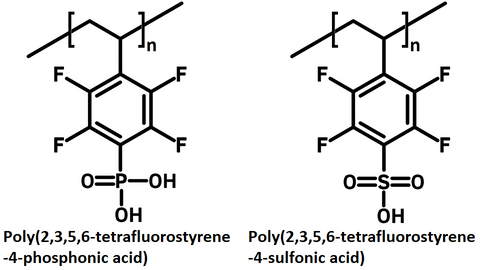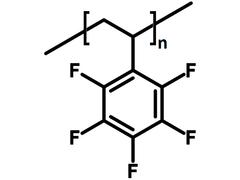Poly(pentafluorostyrene)
CAS Number 26838-55-1
Materials, Optoelectronic Materials, Photonic and Optical MaterialsPoly(pentafluorostyrene), high heat & chemical resistance, low refractive index & dielectric constant
For applications in the field of optoelectronics such as a cladding layer in optical waveguide, and design of polylectrolytic membranes for fuel cells
Specifications | Pricing and Options | MSDS | Literature and Reviews
Poly(pentafluorostyrene) (PPFS), CAS number 26838-55-1, is a highly fluorinated homopolymer of pentafluorostyrene monomer via free radical polymerization. Due to its high ratio of fluoro content in the polymer, poly(pentafluorostyrene) offer great thermal stability with high heat and high chemical resistance, as well as oil and water repellence.
Poly(pentafluorostyrene) also exhibits low refractive index and low dielectric constant which has potential application in microelectronics or as an antifouling and antifogging agent, and as cladding layer in optical waveguide.
Highly fluorinated homopolymer
For optielectronic applications
Enables post-functionalization
The fluoride substituents can undergo nucleophilic aromatic substitution
Worldwide shipping
Quick and reliable shipping
High purity
>98% High purity
Fluoro at 4-positon offers great chemistry for post-modification by aromatic nucleophilic substitution reaction. It can be substituted by sulfur or phosphorus functional groups for further applications as membranes in fuel cells and redox follow battery. Starting with poly(pentafluorostyrene),100% sulfonation can be achieved by thiolation with metal sulfide and then oxidation of the thiol-functions to the corresponding sulfonic acids. Sulfonated poly(pentafluorostyrene) shows great improvement of the proton-conductivity being 35 mS cm-1 (at 160 °C, p = 105 Pa water vapor pressure), an order of magnitude higher than those of Nafion measured under the same conditions.

Poly(2,3,5,6-tetrafluorostyrene-4-phosphonic acid), can also be directly synthesized by using poly(pentafluorostyrene) as one of the starting materials that does not require anhydride formation and thus maintains protonic conductivity above 200 °C. The use of the phosphonated poly(pentafluorostyrene) in fuel cell electrodes with an ion-pair coordinated membrane outperforming polybenzimidazole- and metal phosphate-based fuel cells with peak power densities of 1,130 mW cm-2 at 160 °C and 1,740 mW cm-2 at 240 °C under H2/O2 conditions.
Chemical Structure

General Information
| CAS Number | 26838-55-1 |
| Chemical Formula | (C8H3F5)n |
| Full Name | Poly(2,3,4,5,6-pentafluorostyrene) |
| Purity | >98% (1HNMR) |
| Form | White powder/crystals |
| Solubility | Acetone, MEK, NEP, THF |
| Melting Point | Tg = 80 °C |
| Synonyms | PPFS, 2,3,4,5,6-Pentafluorostyrene homopolymer, Poly[(pentafluorophenyl)ethylene] |
| Classification / Family | Polystyrenes, Fluorinated polymers, Photonic and optical materials |
Pricing
| Batch | Quantity | Price |
| M2370A2/3 | 1 g | $360 |
| M2370A3 | 5 g | $1,425 |
Batch details
| Batch | Mw | Mn | PDI | Stock Info |
| M2370A1 | 85,055 | 52,369 | 1.6 | Discontinued |
| M2370A2 | 90,685 | 54,696 | 1.7 | In stock |
| M2370A3 | 70,467 | 45,970 | 1.5 | In stock |
MSDS Documentation
Literature and Reviews
-
Sulfonated poly(pentafluorostyrene): Synthesis & characterization, V. Atanasov et al., Solid State Ion., 252 (1), 75-83 (2013); DOI: 10.1016/j.ssi.2013.06.010.
- Synergistically integrated phosphonated poly(pentafluorostyrene) for fuel cells, V. Atanasov et al., Nat. Mater., 20, pages 370–377 (2021); DOI: 10.1038/s41563-020-00841-z.
- Covalent immobilization of luminescent oxygen indicators reduces cytotoxicity, H. Välimäki et al., Biomed Microdevices 22, 41 (2020); DOI: 10.1007/s10544-020-00495-3.
